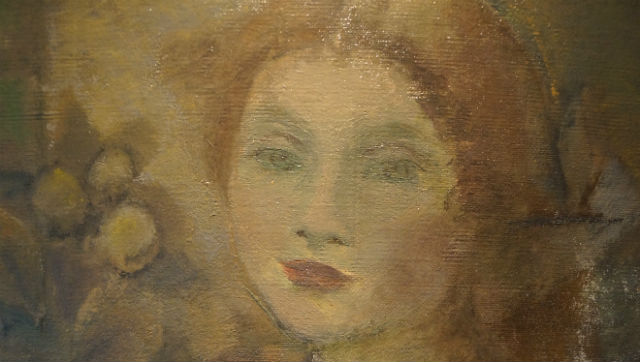
PORTLAND, Ore. (AP) – Edward Engelberg, a Portland resident who came to the U.S. as a refugee from Nazi Germany, has always been fascinated by the painting his family brought with them.
It depicts a woman in a Mona Lisa-like pose, smiling faintly.
But more than the painting itself, Engelberg – now 86 – was drawn to its story.
His mother had bartered the painting’s twin, a similar portrait of a smiling woman, in exchange for the Swiss visa that secured his father’s freedom from the Dachau concentration camp.
That painting saved the Engelbergs’ lives, allowing a 9-year-old boy who knew no English to grow up to become a Fulbright Scholar and college professor.
Now, more than 70 years later, the mystery of the missing painting may have been solved by a team of German journalists who spent months searching for clues to its whereabouts.
“That painting saved my entire family,”’ Engelberg says.
The painting’s journey began on Kristallnacht, Nov. 9, 1938 – the Night of Broken Glass.
Edward Engelberg, living in a Munich apartment with his mother, father and sister, awoke after the Gestapo’s rampage to find his school and the adjoining synagogue on fire. The boy ran home to another horror. His father, Jakob Engelberg, was among some 30,000 Jewish men arrested and sent to concentration camps in the immediate aftermath of Kristallnacht.
Jakob went to Dachau. Tens of thousands of Jews died there during the 12 years between the Nazi camp’s opening and the end of World War II.
Like many Jews imprisoned after Kristallnacht, Jakob Engelberg was offered release if he promised to flee the country within days. The Engelberg family lacked the means to fulfill that order.
They had applied years earlier for U.S. visas, and had just learned Paula and the kids were approved for entry. Jakob’s Polish heritage meant he had to keep waiting.
The U.S. government, at the time, tightly restricted immigration. Eastern Europeans, in particular, had difficulty gaining entry.
Jakob was still waiting when the police took him away.
“A lot of people said of the German Jews, why didn’t they leave? It was so awful, so why did they stay?” said Stephen Engelberg, Edward’s son and a former editor for The Oregonian. “There was no place to go. Nobody wanted to let you in.”
Relatives in Switzerland agreed to host the Engelberg family, but the visa needed the Swiss consul’s approval.
Edward never learned the details. He only remembers watching his mother, Paula, gather up the portrait by German artist Otto Stein before departing for the consulate. She returned with a valid visa, but no artwork.
Two weeks into his imprisonment, Jakob was released.
“We had 48 hours to go,” Edward said.
Jakob, Edward, and his sister, Melly, boarded a train to Switzerland. Paula stayed behind to turn the family’s money and valuables over to the Nazis, then met them in Zurich. The remaining painting was among the few belongings that survived the move.
Lives that easily could have ended in Dachau or Buchenwald or Sachsenhausen continued in New Jersey and Brooklyn.
Jakob and Paula died young. Edward, who didn’t begin to learn English until age 10, went on to become a professor of comparative literature at Brandeis University. Melly became an English teacher.
He raised three children to Melly’s four. Their children begat 13 grandchildren.
“Twenty-four lives and counting, that painting saved,” Edward Engelberg says.
Through the years, the artwork remained an item of lore in the Engelberg family, its whereabouts unknown.
Stephen, who is editor-in-chief at ProPublica, shared the story in 2010 with Christian Salewski, a German reporter visiting ProPublica on a fellowship. Five years later, Salewski and a team of journalists set out to locate the painting. They called their mission Kunstjagdt, or “Art Hunt.”
“There is a point when, as a reporter, you hear a story and you just know this is something you want to investigate,” Salewski said. “We never thought we could get even close to finding it.”
The Art Hunt reporters crisscrossed Europe on their investigation, using social media to enlist civilians in the search. The world’s leading expert on Otto Stein’s artwork helped them narrow the possibilities down to a handful of paintings.
Salewski flew to Portland with the one he believed Paula Engelberg might have exchanged for her family’s freedom.
“It struck a nerve,” Edward Engelberg said. The woman in the image, brown hair pulled back in a loose fashion, closely resembles the one Engelberg remembers from his childhood.
But it’s difficult to be certain.
Engelberg remembers watching his mother roll it up before leaving the family’s apartment. The portrait the Art Hunt reporters found is too stiff to roll.
“I feel very ambivalent about it,” Engelberg said.
Still, the painting’s owner insisted Engelberg should have it. Both the family heirloom portrait and the one Paula Engelberg might have traded for the visa are on display at the Jewish Museum Munich.
When the exhibit ends next month, both pieces will be shipped to Portland where Edward Engelberg plans to hang them in his apartment.
___
By KELLY HOUSE, The Oregonian
The original story can be found on The Oregonian’s website: http://bit.ly/21wu71H
Copyright 2015 Associated Press. All rights reserved. This material may not be published, broadcast, rewritten, or redistributed.
AP-WF-12-04-15 1842GMT



